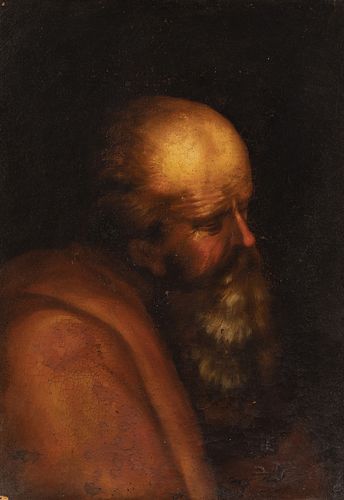Spanish school; XVII century. "Bust of St. Paul". Oil on canvas.
Lot 75
About Seller
Setdart Auction House
Carrer Aragó 346
Barcelona
Spain
Setdart Subastas was born in 2004 and is currently the first online art auction in Spain with solidity, prestige and reliability guaranteed by our more than 60,000 users. Setdart has a young, dynamic and enterprising team ready to successfully manage the purchase and sale of art works through custom...Read more
Estimate:
EUR€700 - EUR€900
$760.87 - $978.26
Absentee vs Live bid
Two ways to bid:
- Leave a max absentee bid and the platform will bid on your behalf up to your maximum bid during the live auction.
- Bid live during the auction and your bids will be submitted real-time to the auctioneer.
Bid Increments
| Price | Bid Increment |
|---|---|
| EUR€0 | EUR€10 |
| EUR€200 | EUR€25 |
| EUR€500 | EUR€50 |
| EUR€1,000 | EUR€100 |
| EUR€3,000 | EUR€200 |
| EUR€5,000 | EUR€500 |
| EUR€10,000 | EUR€1,000 |
| EUR€20,000 | EUR€2,000 |
| EUR€50,000 | EUR€5,000 |
About Auction
By Setdart Auction House
Nov 3, 2021
Set Reminder
2021-11-03 08:00:00
2021-11-03 08:00:00
America/New_York
Bidsquare
Bidsquare : OLD MASTERS
https://www.bidsquare.com/auctions/setdart-auction-house/old-masters-7786
Setdart Auction House sofia@setdart.com
Setdart Auction House sofia@setdart.com
- Lot Description
Spanish school; XVII century. "Bust of St. Paul". Oil on canvas. Presents repainting, restorations, hole and missing in the frame. Measurements: 54 x 39.5 cm; 61 x 46 cm (frame). Saint Paul was a Hellenized Jew of the Diaspora, born in Tarsus. He was therefore Jewish by ethnicity, Greek by culture and Roman by nationality. He received the name Saul, which he changed to Paul after his conversion. Born at the beginning of the first century, he studied in Jerusalem with Rabbi Gamaliel, who was known for his hatred of Christians. One day, when around the year 35 he was on his way from Jerusalem to Damascus, he was dazzled by lightning and fell from his horse. Then he heard the voice of Jesus saying to him: "Saul, Saul, why are you persecuting me? As a result of this experience, the saint went abruptly from persecutor to zealot of Christianity. After curing the blindness of a Christian from Damascus, he began his life as a missionary, until he arrived in Jerusalem where he came into contact with Peter and the other apostles. In the Middle Ages, numerous corporations were placed under his patronage, due to different aspects of his iconography, life and miracles. However, St. Paul was never a popular saint, which proves the relative poverty of his iconography. In fact, the role he occupies in art is out of proportion to his importance in the spread of Christianity. In early Christian art, his only attributes are a book or a scroll, and in the 13th century his emblem appears, the sword that was the instrument of his martyrdom.
- Shipping Info
-
In-house shipping available. Please inquire at admin@setdart.com.
-
- Buyer's Premium



 EUR
EUR CAD
CAD AUD
AUD GBP
GBP MXN
MXN HKD
HKD CNY
CNY MYR
MYR SEK
SEK SGD
SGD CHF
CHF THB
THB














